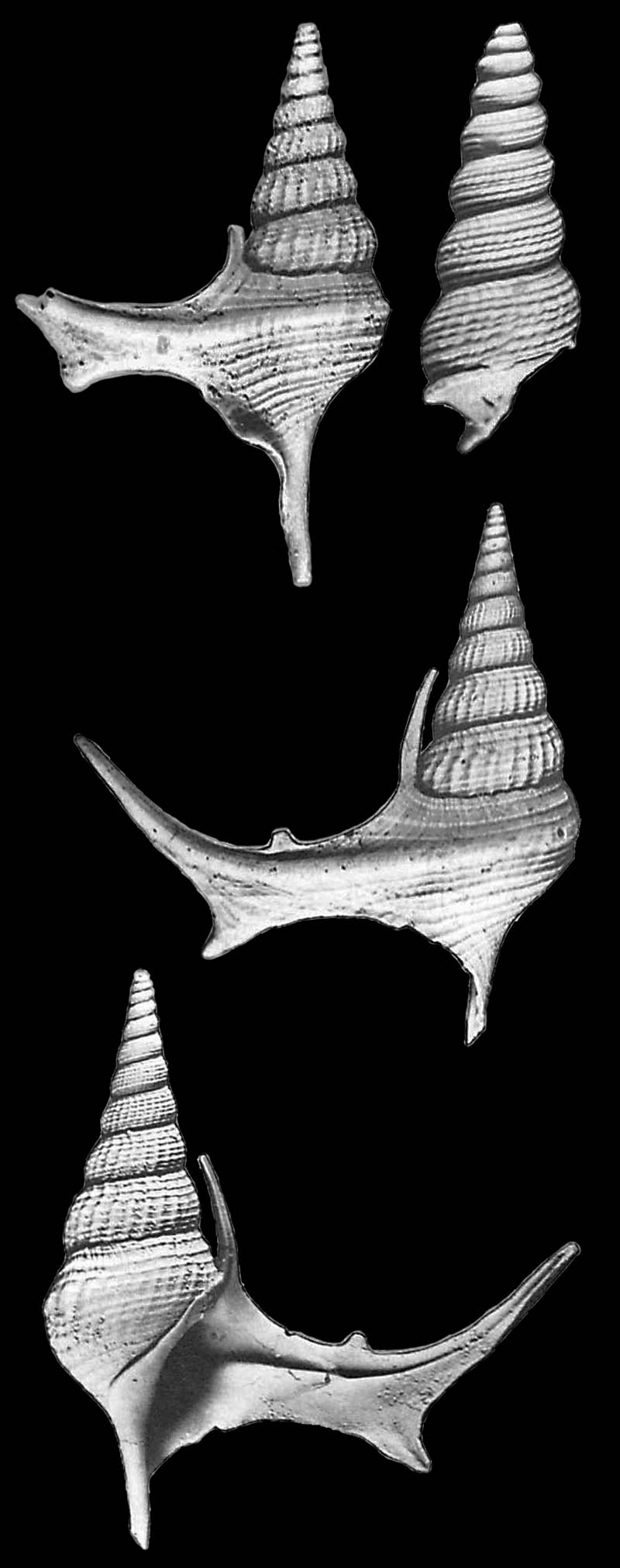Species / Anchura Chapelvillensis
Stromboidea
Original Diagnosis of Anchura chapelvillensis by Dockery, 1993, p. 64:
- "Small sized Anchura with a sculpture like that of the type species though finer and with an outer lip having a narrow shank with a long and narrow posterior arm, a spur-like anterior arm, a concave distal margin, a long, recurved, channeled proximal spine above the aperture's anterior canal, and which may or may not have a median spine."
Original Description of Anchura chapelvillensis by Dockery, 1993, p. 64:
- "Only the last one and one fourth whorl of the protoconch is known. This whorl is smooth and has a rounded carina or shoulder. The junction of the protoconch and teleoconch is abrupt. The teleoconch consists of ten and one half whorls, the first two of which are carinate and are sculptured with eight spiral lirae, the fourth one below the suture forming the carina, and fine opisthocline ribs which are concave toward the aperture. The next four whorls are evenly convex and are sculptured with eight strong spiral lirae and weaker opisthocline ribs. On the seventh whorl the axial ribs surpass the spiral lirae in strength, the apical angle broadens, and a secondary lira appears between the first and second lirae below the suture. The axial ribs continue to increase in size on the eighth and penultimate whorls and additional secondary lirae appear between the eight primaries. On the penultimate whorl the Arrangement of the spiral lirae is like that found in the type species, with five closely spaced lirae on the whorl's lower half and three broadly spaced lirae on the upper half. The fourth lira below the suture (the uppermost of the lower lirae) forms a carina on the body whorl that extends as a ridge onto the outer lip and up the posterior arm. The outer lip has a narrow shank that has a long, narrow, recurved, proximal spine extending from the subsutural collar of the body whorl. It may or may not also have a median spine (about one half of the specimens do). The shank terminates into a long and narrow posterior arm and a spur-like anterior arm and has a concave distal margin. The aperture is lenticular with an anterior canal extending up the proximal spine of the outer lip. It also has a long and narrow channel extending onto the shank of the outer lip and up the posterior arm and has a long, straight anterior rostrum. The inner lip has a strong callus. The shell's base is sculptured below the carina with seven primary spiral lirae and additional secondary ones."
Locus typicus:
- MGS 129: Griffin pit on the east side of the Friendship-Pratt Road and on the south valley wall of Twenty Mile Creek, Lee County, Mississippi, USA
Stratum typicum:
- Chapelville Horizon of the Tupelo Tongue of the Coffee Sand, Campanian, upper Cretaceous
Measurements: The holotype measures 35,0 mm in height and 32,5 mm in width.
Types: Holotype 456999 USNM.
Etymology: Named for the type horizon - the Chapelville horizon of the Coffee Sand.
Anchura chapelvillensis Dockery, 1993, pl. 14, figs. 4-7
Discussion by Dockery, 1993, p. 64:
- "The outer lip of this species has a narrow shank,a Long and narrow posterior arm,and a spur-like anterior arm, as does the type species Anchura abrupta, but is half ist size. It also differs from the type species in having a Long recurved proximal spine and in the presence of a median spine on the outer lip's shank. The occurrence of a median spine in only half the specimens collected suggests that this feature may be due to sexual dimorphism. A. chapelvillensis is rather common in bed B of the Chapelville horizon at MGS locality 129."
References:

